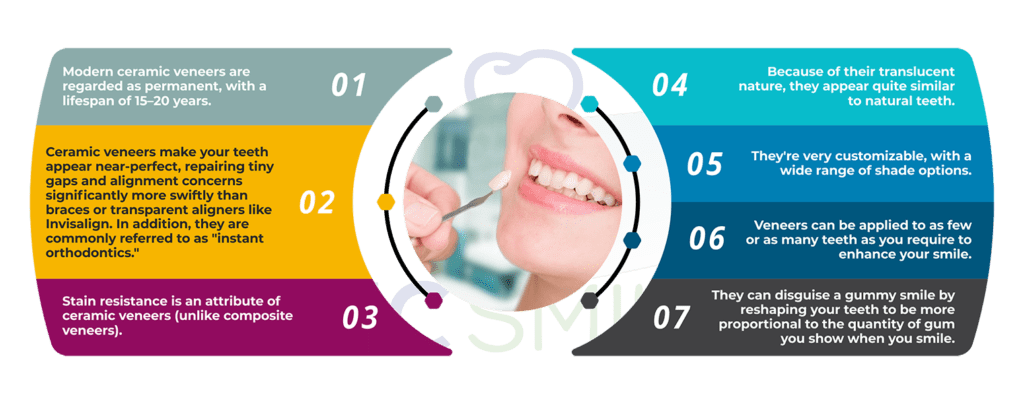Ceramic Veneer

Ceramic Veneer
Dental veneers generally referred to as dental porcelain laminates or porcelain/ceramic veneers, are tooth-colored, custom-made, wafer-thin shells of material intended to cover the front surface of your teeth to enhance their look. Veneers are often constructed of resin composite materials or porcelain, and they alter the length, size, shape, or color of the teeth. Veneers are used to address a variety of aesthetic issues such as smaller, discolored, cracked, or chipped teeth. Veneers are normally put to the top front eight teeth. In the case of a chipped or damaged tooth, some people may only require one veneer, while many require up to eight to get an equal smile.
Types of Dental Veneers
Veneers are classified into two types: porcelain and composite.

Composite Veneers
Composites may have a less appealing look, but they are substantially less expensive than porcelain. They also have a shorter life lifetime and, after a while, become unappealing, staining, or chipping away. Composites are the appropriate alternative when a patient wishes to repair a tooth that is too little or too short since the procedure is reversible. The composite may be fitted without removing any enamel from the tooth.
Porcelain/Ceramic Veneers
Veneers composed of porcelain or ceramic, on the other hand, are significantly more durable and have a longer life span. Because the material is transparent, they closely resemble original teeth, and porcelain is stain resistant. The most significant disadvantage of porcelain is that it is at least twice as expensive as composite. Furthermore, when you have veneers, you're committing to a lifetime of teeth covering since once the enamel is gone, your teeth can't be uncovered again.

Benefits of Ceramic Veneers

You must be in good dental health to have any type of veneer, so any concerns that go beyond the aesthetic must be addressed first. Your dentist will inspect your mouth to ensure that you don’t have any underlying problems, such as tooth decay. They may also take X-rays to ensure the structural integrity of your teeth. Minor misalignment is OK, but if you have severely crooked teeth, you’ll almost certainly require braces or clear aligners before you can go this way.
You won’t feel any pain since you’ll be anesthetized when the veneers are put. Recovering isn’t unpleasant in and of itself, but you may have some soreness as your gums adjust to your new teeth, especially if you’ve had more than eight veneers placed. Approximately half of the veneer patients also have bonding sensitivity, which indicates that the bonding cement hurts their teeth. It can cause discomfort for up to six hours after the anesthetic wears off, after which it should fade to a dull ache. Consult your dentist if you are still in discomfort a few days after the operation or if your bite feels strange. They can use a file to make minor adjustments or remove small bits of cement that may be lodged between your teeth and causing discomfort.
We provide long-term and accurate solutions to your cosmetic dental issues. There’s no excuse to live with teeth that are damaged, unsightly, or worn out. In every surgery, we utilize the highest quality pieces, and these high-end dental appliances are superior to other types of veneers. Our ceramic veneers will blend in seamlessly with your natural teeth. Our skilled dentist will apply the veneer and verify that it fits properly. Book an appointment today to achieve a beautiful smile!
